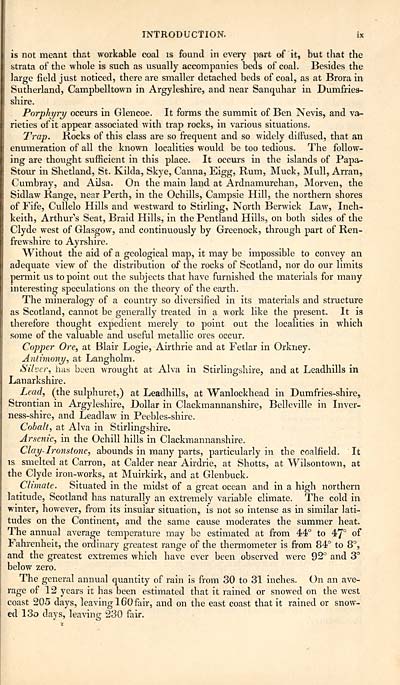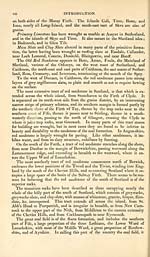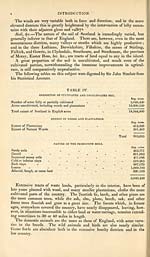Gazetteer of Scotland > Volume 1
(17) Page ix
Download files
Complete book:
Individual page:
Thumbnail gallery: Grid view | List view

INTRODUCTION. ix
is not meant that workable coal is found in every part of it, but that the
strata of the whole is such as usually accompanies beds of coal. Besides the
large field just noticed, there are smaller detached beds of coal, as at Brora in
Sutherland, Campbelltown in Argyleshire, and near Sanquhar in Dumfries-
shire.
Porphyry occurs in Glencoe. It forms the summit of Ben Nevis, and va-
rieties of it appear associated with trap rocks, in various situations.
Trap. Rocks of this class are so frequent and so widely diffused, that an
enumeration of all the known localities would be too tedious. The follow-
ing are thought sufficient in this place. It occurs in the islands of Papa-
Stour in Shetland, St. Kilda, Skye, Canna, Eigg, Rum, Muck, Mull, Arran,
Cumbray, and AUsa. On the main land at Ardnamurchan, Morven, the
Sidlaw Range, near Perth, in the Ochills, Campsie Hill, the northern shores
of Fife, Cullelo Hills and westward to Stirling, North Berwick Law, Inch-
keith, Arthur's Seat, Braid Hills, in the Pentland Hills, on both sides of the
Clyde west of Glasgow, and continuously by Greenock, through part of Ren-
frewshire to Ayrshire.
Without the aid of a geological map, it may be impossible to convey an
adequate view of the distribution of the rocks of Scotland, nor do our limits
permit us to point ovit the subjects that have furnished the materials for many
interesting speculations on the theory of the earth.
The mineralogy of a country so diversified in its materials and structure
as Scotland, cannot be generally treated in a work like the present. It is
therefore thought expedient merely to point out the localities in which
some of the valuable and useful metallic ores occur.
Copper Ore, at Blair Logie, Airthrie and at Fetlar in Orkney.
Antimony, at Langholm.
Silver, has been wrought at Alva in Stirlingshire, and at Leadhills in
Lanarkshire.
Lead, (the sulphuret,) at Leadhills, at Wanlockhead in Dumfries-shire,
Strontian in Argyleshire, Dollar in Clackmannanshire, Belleville in Inver-
ness-shire, and Leadlaw in Peebles-shire.
Cobalt, at Alva in Stirlingshire.
Arsenic, in the Ochill hills in Clackmannanshire.
Clay- Ironstone, abounds in many parts, particularly in the coalfield. It
is smelted at Carron, at Calder near Airdrie, at Shotts, at Wilsontown, at
the Clyde iron-works, at Muirkirk, and at Glenbuck.
Climate. Situated in the midst of a great ocean and in a high northern
latitude, Scotland has naturally an extremely variable climate. The cold in
winter, however, from its insular situation, is not so intense as in similar lati-
tudes on the Continent, and the same cause moderates the summer heat.
The annual average temperature may be estimated at from 44° to 47° of
Fahrenheit, the ordinary greatest range of the thermometer is from 84° to 8°,
and the greatest extremes which have ever been observed were 92° and 3°
below zero.
The general annual quantity of rain is from 30 to 31 inches. On an ave-
rage of 12 years it has been estimated that it rained or snowed on the west
coast 205 days, leaving 160 fair, and on the east coast that it rained or snow-
ed 13o days, leaving 230 fair.
is not meant that workable coal is found in every part of it, but that the
strata of the whole is such as usually accompanies beds of coal. Besides the
large field just noticed, there are smaller detached beds of coal, as at Brora in
Sutherland, Campbelltown in Argyleshire, and near Sanquhar in Dumfries-
shire.
Porphyry occurs in Glencoe. It forms the summit of Ben Nevis, and va-
rieties of it appear associated with trap rocks, in various situations.
Trap. Rocks of this class are so frequent and so widely diffused, that an
enumeration of all the known localities would be too tedious. The follow-
ing are thought sufficient in this place. It occurs in the islands of Papa-
Stour in Shetland, St. Kilda, Skye, Canna, Eigg, Rum, Muck, Mull, Arran,
Cumbray, and AUsa. On the main land at Ardnamurchan, Morven, the
Sidlaw Range, near Perth, in the Ochills, Campsie Hill, the northern shores
of Fife, Cullelo Hills and westward to Stirling, North Berwick Law, Inch-
keith, Arthur's Seat, Braid Hills, in the Pentland Hills, on both sides of the
Clyde west of Glasgow, and continuously by Greenock, through part of Ren-
frewshire to Ayrshire.
Without the aid of a geological map, it may be impossible to convey an
adequate view of the distribution of the rocks of Scotland, nor do our limits
permit us to point ovit the subjects that have furnished the materials for many
interesting speculations on the theory of the earth.
The mineralogy of a country so diversified in its materials and structure
as Scotland, cannot be generally treated in a work like the present. It is
therefore thought expedient merely to point out the localities in which
some of the valuable and useful metallic ores occur.
Copper Ore, at Blair Logie, Airthrie and at Fetlar in Orkney.
Antimony, at Langholm.
Silver, has been wrought at Alva in Stirlingshire, and at Leadhills in
Lanarkshire.
Lead, (the sulphuret,) at Leadhills, at Wanlockhead in Dumfries-shire,
Strontian in Argyleshire, Dollar in Clackmannanshire, Belleville in Inver-
ness-shire, and Leadlaw in Peebles-shire.
Cobalt, at Alva in Stirlingshire.
Arsenic, in the Ochill hills in Clackmannanshire.
Clay- Ironstone, abounds in many parts, particularly in the coalfield. It
is smelted at Carron, at Calder near Airdrie, at Shotts, at Wilsontown, at
the Clyde iron-works, at Muirkirk, and at Glenbuck.
Climate. Situated in the midst of a great ocean and in a high northern
latitude, Scotland has naturally an extremely variable climate. The cold in
winter, however, from its insular situation, is not so intense as in similar lati-
tudes on the Continent, and the same cause moderates the summer heat.
The annual average temperature may be estimated at from 44° to 47° of
Fahrenheit, the ordinary greatest range of the thermometer is from 84° to 8°,
and the greatest extremes which have ever been observed were 92° and 3°
below zero.
The general annual quantity of rain is from 30 to 31 inches. On an ave-
rage of 12 years it has been estimated that it rained or snowed on the west
coast 205 days, leaving 160 fair, and on the east coast that it rained or snow-
ed 13o days, leaving 230 fair.
Set display mode to: Large image | Transcription
Images and transcriptions on this page, including medium image downloads, may be used under the Creative Commons Attribution 4.0 International Licence unless otherwise stated. ![]()
| Gazetteers of Scotland, 1803-1901 > Gazetteer of Scotland > Volume 1 > (17) Page ix |
|---|
| Permanent URL | https://digital.nls.uk/97424566 |
|---|
| Description | Volume I: Abbey to Glenartney. |
|---|---|
| Attribution and copyright: |
|
| Description | By Robert Chambers and William Chambers. Glasgow: Blackie & Son, 1838. 2 volumes. |
|---|---|
| Shelfmark | NF.1461.g.7 |
| Additional NLS resources: | |

